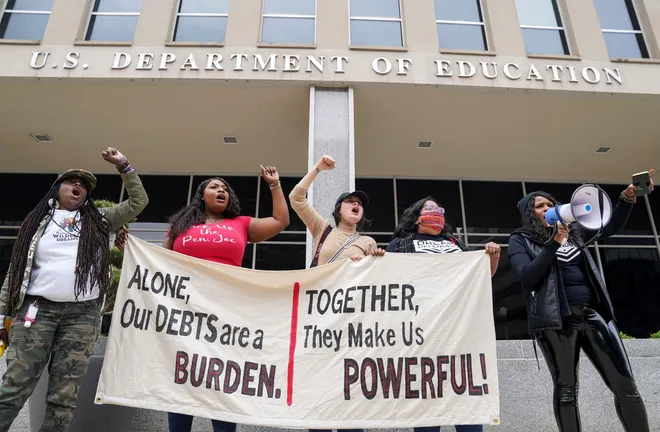
Now that it’s unlikely millions of Americans will get student loan forgiveness by year-end, they should prepare (and quickly) to start repaying again, experts say.
A federal appeals court unanimously voted Monday to issue a nationwide injunction barring the Biden administration’s student loan debt relief program until the question is resolved in court. The Biden administration could ask the Supreme Court to lift the injunction. Either way, a resolution could take months and certainly won’t come by the end of the year, when the student loan repayment pause expires.
That means everyone with student debt probably will have to start repayments on Jan. 1 unless the administration can devise a new plan that can avoid court battles, experts say.
Even if the administration does come up with a new plan, it probably will be narrower than the one stuck in the courts, which is why “I’m telling people to expect to start paying again,” said Brian Marks, executive director of the Entrepreneurship and Innovation Program at the University of New Haven in Connecticut.
How many Americans with student debt does this affect?
A simple debt forgiveness application was launched around mid-October. About 26 million Americans had already applied for forgiveness and 16 million people already received debt relief approval when the Department of Education stopped taking applications Nov. 11, the day after a federal judge in Texas declared the debt forgiveness plan unlawful in a separate lawsuit.
The White House estimated over the summer that up to 43 million borrowers, including roughly 20 million borrowers who would have had their full remaining balance canceled, would have been eligible for relief.
What is the income limit for student loan debt forgiveness?
The administration’s plan, announced last summer, would have canceled $10,000 in federal student loans, including Parent Plus loans, for those earning less than $125,000 or households with less than $250,000 in income. Pell Grant recipients, who typically demonstrate more financial need, would get an additional $10,000 in debt forgiven.
What should people do to prepare to start repaying again?
There’s not a lot of time between now and when the pause on student debt repayments expires on Dec. 31, but people need to “get their financial house in order,” Marks said.
Small budget relief:Some prices are dropping, though inflation remains high. Here’s what’s cheaper.
Here are some steps to take before year-end:
- Start cutting expenses and increasing savings, Marks said, acknowledging it has been a rough year with the highest inflation in a generation. The times “call for prudence and creativity,” he said, recalling when he and his wife first got married and had little money, they took long walks or spent their date night grocery shopping instead of at a movie – neither cost much money.
- Know what your payments will look like and whether you’ll be able to afford them. If not, and if you don’t qualify for forgiveness, it may make sense to refinance at a lower interest rate if possible before payments restart, Randy Lupi, financial professional with Equitable Advisors, said. Just note, though, that once loans are refinanced with a private company, they will no longer be eligible for any federal forgiveness programs, he said.
- Check your eligibility for other government loan forgiveness programs. “For example, individuals in the nonprofit field likely qualify for Public Service Loan Forgiveness, which does not have a cap on the amount of forgiveness and should take this time to make sure they are properly enrolled,” Lupi said.
- Consider paying your loan down before Jan. 1. Because the student loan repayment pause includes a 0% interest rate, 100% of payments made during the pause goes toward your principal, said Eric Schuppenhauer, head of national banking and lending at Citizens Bank. If you trim your loan amount, you may be able to cut the length of the loan and save money in the long run.
- Check your eligibility for income-driven repayment plans. Federal student loans offer income-driven repayment plans that can reduce your monthly payments.
- Check with your employer. An Employee Benefit Research Institute survey last year showed that 17% of employers offer student loan debt assistance and another 31% plan to do so. For example, Aetna matches employees’ U.S.-based student loan payments up to $2,000 a year for a lifetime maximum of up to $10,000 for qualifying loans; PwC offers associates and senior associates up to $1,200 a year toward student debt; and Google matches up to $2,500 a year.